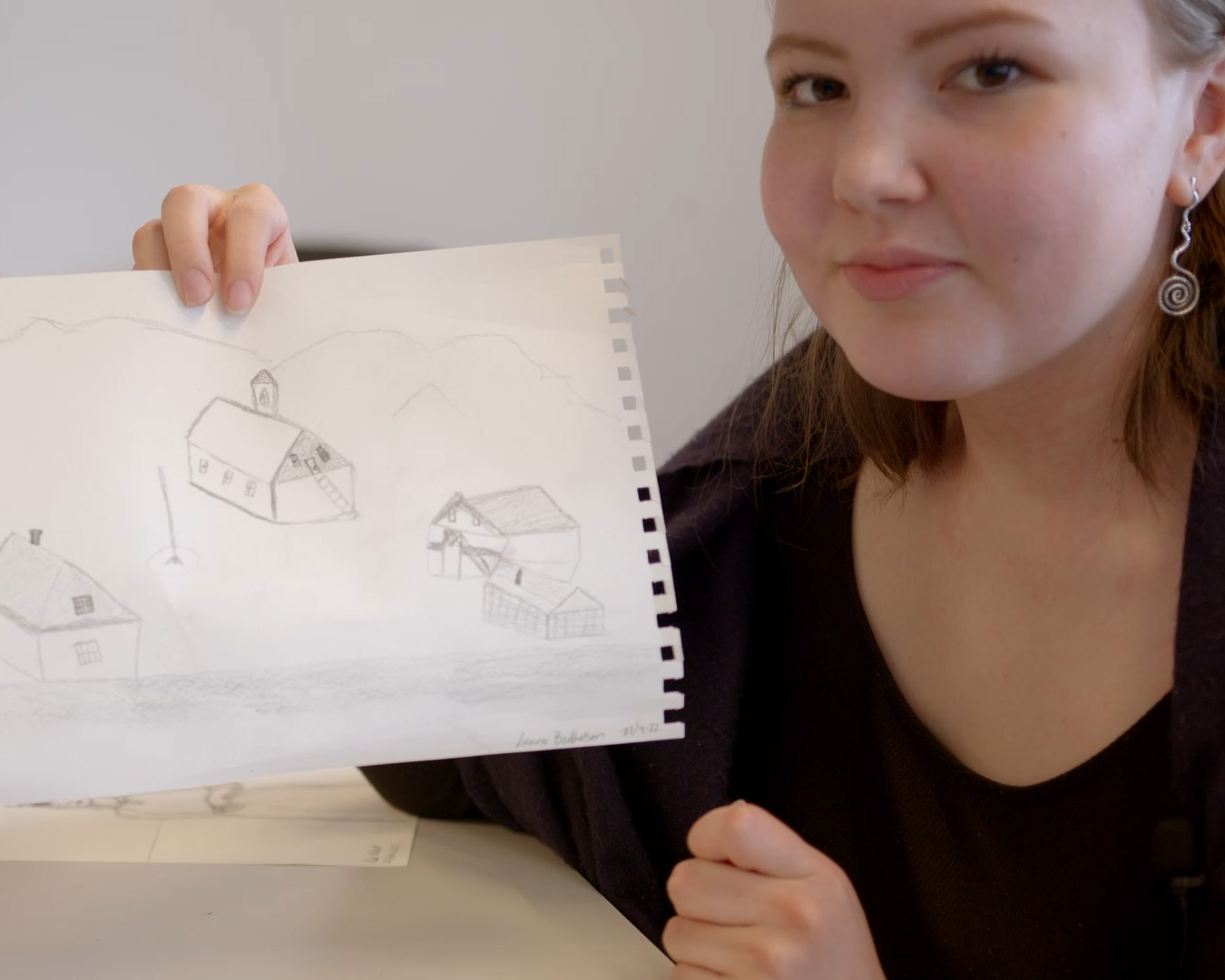Research project: Students draw places in Sisimiut
Researchers recently held a drawing workshop at GUX in Sisimiut. Here, Nuka K. Godtfredsen taught the students how to tell their own story through drawings.
Af Nicoline Larsen
A number of students at GUX in Sisimiut were tasked with drawing a local place that they like.
In front of the board were the artist Nuka K. Godtfredsen and two researchers, Frederik Fuuja Larsen from the National Museum of Greenland and Anne Mette Randrup Jørgensen from the National Museum of Denmark.
The drawing workshop is part of the research project Activating Arctic Heritage, which is a collaboration between the two countries’ national museums. As something new, they are experimenting with using drawings in their research activities.
Arctic Hub came along to see how the project tries new creative methods to involve locals in their research.
Researching cultural heritage
The research project Activating Arctic Heritage examines the intangible cultural heritage found in the two UNESCO areas Aasivissuit-Nipisat in West Greenland and Kujataa in South Greenland. Here, the researchers collect stories from the people who know the area best – those who have lived here for the last 4,500 years. Including those who live in the area today.

“We’re very interested in stories about the landscape,” Anne Mette Randrup Jørgensen, Senior Researcher at the National Museum in Denmark, explains. “That’s why we collect stories and look at the stories that have already been collected.”
Experimenting with drawings
Up until now, researchers at Activating Arctic Heritage have conducted interviews with locals and looked at previously written accounts. However, using drawings to gain insight into people’s experiences with the area is a new approach for them. The senior researcher continues:
“We turn to drawings now to experiment with using a different language than the written word. Drawings are amazing storytellers. For our workshop in Sisimiut, for example, someone drew the famous ‘Kællingehætten’ mountain illuminated by the northern lights. It was an incredibly beautiful drawing of something she liked, and it set us thinking about what kind of places in the landscape we actually use.”
Nuka K. Godtfredsen also believes that drawings are a good way to get people to think about how they actually use the area. And maybe they also help invite other, less heard voices to join the conversation.
“It’s important that researchers do not come here to collect data and leave again straight away,” Frederik Fuuja Larsen
“Through drawings, people can tell stories about their unique lives and experiences. Be it about their home or about a recent boat trip. It lets everyone tell stories from and about their everyday life.”
Local involvement is crucial to research
No one is going to examine the GUX students’ drawings. The drawing workshop is first and foremost a part of the research project’s efforts to involve the local community, Frederik Fuuja Larsen, Museum Inspector at the Greenland National Museum, explains.

“It’s important that researchers do not come here to collect data and leave again straight away. That’s not how it should be. We must involve the locals and remember to include and listen to their stories because they know the history of their area best,” says Frederik Fuuja Larsen.
The past is key to the future
Among other things, Activating Arctic Heritage examine how the Aasivissuit-Nipisat area has adapted to climate change over time. Both researchers emphasize that history does not only belong to the past.
“When you work with history, it’s also always about the future,” Anne Mette Randrup Jørgensen.
“In our research, we use the past as a starting point to say something about the future. When we talk about climate change, it is important to understand that there have always been ongoing changes to the climate. That’s why we’re looking at how people have adapted to such changes in the past. Maybe we can apply their knowledge to our future.”
Recognizing that cultural heritage points both back and forth in time, Activating Arctic Heritage makes a special effort to involve young people. Because as Frederik Fuuja Larsen says: “The young people’s attitudes to the future are highly relevant. After all, they are the ones who are going to inhabit it.”
In addition to the workshop at GUX, Nuka K. Godtfredsen and the researchers also held drawing workshops at a school in Sisimiut and for citizens in Kangerlussuaq, as well as giving presentations at the Sisimiut Museum. In this interactive map, you can see some of the many stories that the researchers have collected.
In the video above you can see how it went when Nuka K. Godtfredsen held a drawing workshop for the students at GUX in Sisimiut.